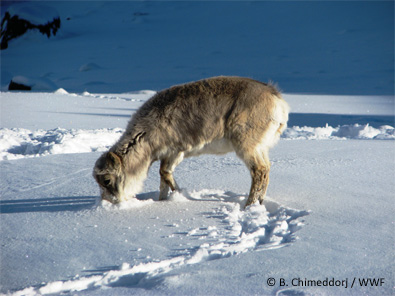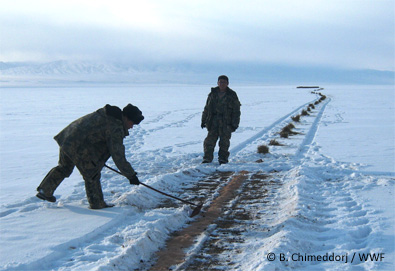This year, Mongolia is affected by a “dzud”, a natural disaster consisting of a summer drought, followed by heavy snowfall with extreme cold temperatures. The heavy snowfall and extreme cold temperatures (up to -50 degrees centigrade) have lead to a massive death of the livestock. According to the National Statistical Office of Mongolia, over 5 million livestock had died so far, and the mortality is expected to increase until end of spring.
Fortunately, saiga mortality is relatively low comparing to the previous dzuds that occurred 10 years ago, because southern range of saiga distribution is not affected by heavy snow. During the harsh winters of 2000 and 2001, approximately 75% of the total saiga population crashed. Local herders and saiga rangers reported that saiga have changed their range greatly, and penetrated into new areas, from the desert basins up to higher elevations, avoiding the thick snow and searching for food.
However, the situation in northern area of saiga range is much more vicious for the population, where the whole area is covered by deep snow homogeneously. In order to support starving saiga antelope in northern range, WWF Mongolia has taken urgent measures. A project team spent about 4000 USD to deliver and distribute the pressed hays to saiga area under supervision of scientists, saiga rangers and local herders.
Given the fact that the dzud condition has led to a mass mortality of livestock within and beyond saiga range, WWF Mongolia is concerned about possible increase of poaching for wildlife related products including saiga horn as an alternative income. Nevertheless, thanks to comprehensive law enforcement efforts of WWF Mongolia such as Mobile Anti Poaching Unit, Saiga rangers’ Network and Volunteer rangers, there is no incident of saiga poaching recorded this winter.
To note, a joint project between Wildlife Conservation Society and Mongolian Academy of Sciences started in 2008 to understand survival and mortality of saiga calves in western Mongolia. Within the framework of the project we collared total 80 new born saiga calves in last 2 summers. By the end of November, 2009, total of 31 saigas calves (11 from 2008) have been survived. We have planned to resume the monitoring of collared saiga animals that suspended in late fall of 2009 due to logistical difficulty. Therefore, the results from the monitoring of post-winter survival will enable us to understand how harsh the winter was for the both adults and calves of saiga population in western Mongolia.
To support EDGE Fellows, like Buuvei, who are researching and conserving one-of-a kind EDGE species, please donate here or become an EDGE Champion.

